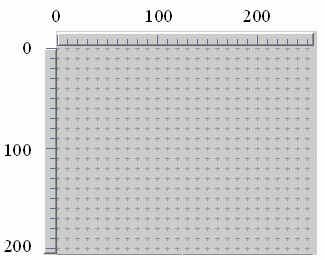|
GUI Layout
An Introduction with Examples in Java |
|
Prof. David Bernstein |
| Computer Science Department |
| bernstdh@jmu.edu |
|
GUI Layout
An Introduction with Examples in Java |
|
Prof. David Bernstein |
| Computer Science Department |
| bernstdh@jmu.edu |
The "Graph Paper" Approach

null
LayoutManager

import java.awt.*;
import javax.swing.*;
/**
* An example of absolute layout with the null layout manager
*
* @version 1.0
* @author Prof. David Bernstein, James Madison Univeristy
*/
public class NullLayoutDriver
{
/**
* The entry point of the example
*
* @param args The command line arguments
*/
public static void main(String[] args)
{
Container contentPane;
JButton cancelButton, okButton;
JFrame frame;
JLabel titleLabel;
frame = new JFrame("A Really Amazing Window!");
frame.setDefaultCloseOperation(JFrame.EXIT_ON_CLOSE);
contentPane = frame.getContentPane();
contentPane.setLayout(null);
titleLabel = new JLabel("An Example of Absolute Layout");
contentPane.add(titleLabel);
titleLabel.setBounds(60,20,290,30);
okButton = new JButton("OK");
contentPane.add(okButton);
okButton.setBounds(190,210,60,30);
cancelButton = new JButton("Cancel");
contentPane.add(cancelButton);
cancelButton.setBounds(260,210,90,30);
frame.setSize(400,400);
frame.setVisible(true);
}
}
FlowLayout

import java.awt.*;
import javax.swing.*;
/**
* An example of relative layout with the FlowLayout manager.
*
* @version 1.0
* @author Prof. David Bernstein, James Madison Univeristy
*/
public class FlowLayoutDriver
{
/**
* The entry point of the example
*
* @param args The command line arguments
*/
public static void main(String[] args)
{
Container contentPane;
JButton cancelButton, okButton;
JFrame frame;
JLabel titleLabel;
JTextArea textArea;
frame = new JFrame();
frame.setDefaultCloseOperation(JFrame.EXIT_ON_CLOSE);
contentPane = frame.getContentPane();
contentPane.setLayout(new FlowLayout());
titleLabel = new JLabel();
titleLabel.setText("An Example of Relative Layout");
contentPane.add(titleLabel);
textArea = new JTextArea(40,20);
contentPane.add(textArea);
okButton = new JButton();
okButton.setText("OK");
contentPane.add(okButton);
cancelButton = new JButton();
cancelButton.setText("Cancel");
contentPane.add(cancelButton);
frame.setSize(400,400);
frame.setVisible(true);
}
}
GridLayout

import java.awt.*;
import javax.swing.*;
/**
* An example of template layout with the GridLayout manager
*
* @version 1.0
* @author Prof. David Bernstein, James Madison Univeristy
*/
public class GridLayoutDriver
{
/**
* The entry point of the example
*
* @param args The command line arguments
*/
public static void main(String[] args)
{
Container contentPane;
JButton cancelButton, okButton;
JFrame frame;
JLabel titleLabel;
JTextArea textArea;
frame = new JFrame();
contentPane = frame.getContentPane();
frame.setDefaultCloseOperation(JFrame.EXIT_ON_CLOSE);
contentPane.setLayout(new GridLayout(2,2));
titleLabel = new JLabel();
titleLabel.setText("An Example of Template Layout");
contentPane.add(titleLabel);
textArea = new JTextArea(40,20);
contentPane.add(textArea);
okButton = new JButton();
okButton.setText("OK");
contentPane.add(okButton);
cancelButton = new JButton();
cancelButton.setText("Cancel");
contentPane.add(cancelButton);
frame.setSize(400,400);
frame.setVisible(true);
}
}
BoxLayout

import java.awt.*;
import javax.swing.*;
/**
* An example of template layout with the BoxLayout manager
*
* @version 1.0
* @author Prof. David Bernstein, James Madison Univeristy
*/
public class BoxLayoutDriver
{
/**
* The entry point of the example
*
* @param args The command line arguments
*/
public static void main(String[] args)
{
Container contentPane;
JButton cancelButton, okButton;
JLabel textLabel, titleLabel;
JFrame frame;
frame = new JFrame("An Example of BoxLayout");
frame.setDefaultCloseOperation(JFrame.EXIT_ON_CLOSE);
contentPane = frame.getContentPane();
contentPane.setLayout(new BoxLayout(contentPane,
BoxLayout.X_AXIS));
titleLabel = new JLabel();
titleLabel.setText("An Example of Template Layout");
contentPane.add(titleLabel);
contentPane.add(Box.createHorizontalStrut(20));
textLabel = new JLabel("Another Label");
contentPane.add(textLabel);
okButton = new JButton();
okButton.setText("OK");
contentPane.add(okButton);
cancelButton = new JButton();
cancelButton.setText("Cancel");
contentPane.add(cancelButton);
contentPane.add(Box.createHorizontalGlue());
frame.setSize(600,400);
frame.setVisible(true);
}
}
BorderLayout
 Example
Exampleimport java.awt.*;
import javax.swing.*;
/**
* An example of template layout with the BorderLayout manager
*
* @version 1.0
* @author Prof. David Bernstein, James Madison Univeristy
*/
public class BorderLayoutDriver
{
/**
* The entry point of the example
*
* @param args The command line arguments
*/
public static void main(String[] args)
{
Container contentPane;
JButton cancelButton, okButton;
JLabel titleLabel;
JTextArea textArea;
JFrame frame;
frame = new JFrame("Using BorderLayout");
frame.setDefaultCloseOperation(JFrame.EXIT_ON_CLOSE);
contentPane = frame.getContentPane();
contentPane.setLayout(new BorderLayout());
titleLabel = new JLabel();
titleLabel.setText("An Example of Template Layout");
contentPane.add(titleLabel, BorderLayout.NORTH);
textArea = new JTextArea(40,20);
contentPane.add(textArea, BorderLayout.CENTER);
okButton = new JButton();
okButton.setText("OK");
contentPane.add(okButton, BorderLayout.SOUTH);
cancelButton = new JButton();
cancelButton.setText("Cancel");
contentPane.add(cancelButton, BorderLayout.EAST);
frame.setSize(400,400);
frame.setVisible(true);
}
}